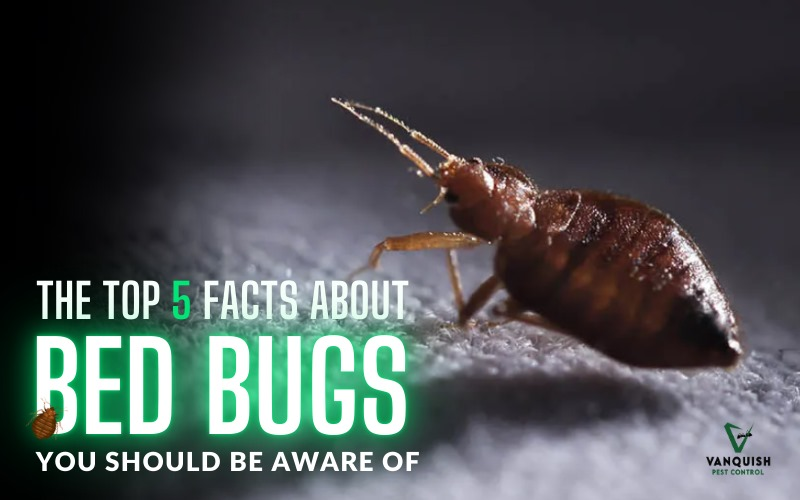Table of Contents
ToggleBed bugs are an issue of growing concern for many property owners, but just how much do you actually know about these little bugs? In this blog, we reveal the top 5 facts about bed bugs that everyone should know in order to stay prepared and pest-free. Whether you are trying to handle an active infestation or just want to learn more in hopes of preventing one, your first step to keeping your space safe and comfortable will be to identify the bed bugs. Let’s dive into these important facts!
Fact #1: Bed Bugs Are Masters of Hiding
Did you know that bed bugs are experts at staying out of sight? Their small size, nocturnal habits, and ability to hide in the tiniest cracks make them one of the most challenging pests to manage. They often conceal themselves in mattress seams, furniture crevices, and other hard-to-spot areas. Their stealthy nature means that by the time you notice signs like bites, they may have already spread significantly. Recognizing their feeding patterns early is crucial to addressing the problem effectively.
Fact #2: Bed Bugs Have a Pattern
Bed bugs follow a consistent feeding routine. They typically feed on a host for 5 to 10 minutes until they are full. Their bite marks often appear in clusters or straight lines, sometimes jokingly called “breakfast, lunch, and dinner.” These marks, usually found on exposed skin like the chest, arms, or legs, are a clear sign of a bed bug problem. Recognizing these patterns can help in identifying their presence early.
Fact #3: Bed Bugs Are Tough to Get Rid Of
Bed bugs can survive for months without feeding, allowing them to hide in furniture, bags, and suitcases until they find a human host. They can also withstand temperatures from near freezing to 122 degrees Fahrenheit. These traits make them hard to eliminate with DIY methods. Professional pest control is the most reliable way to deal with a bed bug problem.
Fact #4: Bed Bugs Can Infest Any Location
While many people associate bed bugs with hotels, these pests can thrive just about anywhere people gather. Bed bugs can be found in single-family homes, apartments, hospitals, college dorms, office buildings, schools, buses, trains, movie theaters, and retail stores. According to the Bugs without Borders study, 89% of pest professionals report treating bed bug problems in homes, and 88% in apartments or condos. Other common areas include hotels (67%), college dormitories (35%), transportation (9%), laundry facilities (5%), and movie theaters (4%).
Fact #5: Bed Bugs Are Evolving
Bed bug research shows that these pests are becoming more resistant to common pesticides. Over time, they’ve evolved to withstand treatments that used to be effective. This evolution makes it even more important to rely on professional pest control services, as they have access to specialized tools and knowledge to combat these increasingly resistant pests.
How Bed Bugs Spread and How to Protect Your Home
While knowing the top 5 facts about bed bugs is crucial, it’s also important to understand how these pests spread and what attracts them to your home. Bed bugs are excellent hitchhikers, often traveling through luggage, clothing, and furniture. They can be introduced into your home from a hotel stay, a visit to a friend’s house, or even through secondhand furniture. Once they’ve made it inside, they seek out warm areas, making your bed, couch, and any other soft furnishings prime spots for nesting.
Common Bed Bug Habitats
Bed bugs prefer dark, tight spaces like mattress seams, cracks in furniture, and baseboards, where they can hide during the day and come out to feed at night. These are known as bed bug hiding spots, and they can be difficult to spot without a thorough inspection.
Minimizing the Risk of Infestation
To reduce the risk of bringing bed bugs into your home, always check the seams and corners of hotel mattresses before settling in, and inspect second hand furniture before bringing it inside. Wash and dry clothing and luggage on high heat after traveling, and keep them off the floor in places like laundry facilities.
How to Inspect for Bed Bugs
Regularly inspect your bed and furniture for signs of bed bugs, such as reddish stains, tiny eggs, or actual pests. If you notice any bed bug bites or suspect an infestation, don’t wait. Early detection is key to stopping an infestation before it spreads and becomes a costly and time-consuming issue. Bed Bugs Extermination Services are equipped with the expertise to thoroughly inspect and eliminate bed bugs from your home.
Conclusion
Knowing these important facts can help you protect your home and loved ones from the nuisance of bed bugs. Early detection and understanding their behaviors are key to preventing them from spreading. Professional pest control is the most effective solution for addressing bed bug challenges. Vanquish Pest Control is dedicated to providing reliable services to keep your space safe and pest-free.
FAQS
What are the key characteristics of a bed bug?
Bed bugs are small, reddish-brown insects, typically about the size of an apple seed, with flat, oval-shaped bodies. They are nocturnal and prefer to hide in cracks and crevices near sleeping areas, emerging at night to feed on blood.
How can you identify a bed bug infestation early?
Early detection of a bed bug infestation is crucial. Look for small, rust-colored stains on sheets, furniture, or walls, which may indicate bed bug droppings or blood spots. Additionally, finding eggs, empty skins, or an increase in bite marks on the skin can signal an infestation.
What methods are most effective in eradicating bed bugs?
Professional pest control services typically use a combination of chemical treatments, heat treatments, and vacuuming to eradicate bed bugs. Heat treatment involves raising the temperature of affected areas to a level that kills bed bugs at all life stages. A thorough, integrated pest management approach is often required for long-term success.

